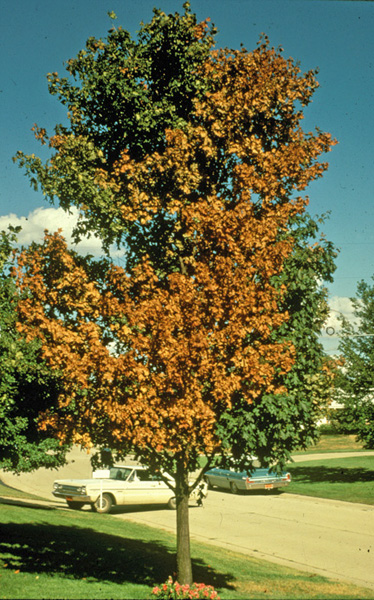Issue 8, June 12, 2009
Is Verticillium Wilt Killing My Tree?
Verticillium wilt is a name that is associated with sudden death of mature trees, shrubs, perennials, and vegetables. In Illinois, this fungal disease may be caused by either Verticillium dahliae or Verticillium albo-atrum. Sometimes plants wilt, but more often foliage turns brown and dies over a period of weeks or months as shown in this dated picture of Verticillium wilt on maple. Once the causal fungus enters the vascular tissues of the host plant, it is likely to spread quickly, block the water conducting vessels, and cause plant death. Generally, infected plants do not recover.

Clients often submit tree samples to the University of Illinois to be tested for the presence of Verticillium. Maple, redbud, and smoketree have been the most common hosts. In recent years magnolia has joined the list of commonly infected species. If your magnolia tree shows branch by branch decline or an overall thinning of the branches, cut into a few finger sized branches and look for staining of the wood.
A diagnostic clue for detecting Verticillium wilt is the presence of vascular streaking or vascular discoloration as shown in the maple wood in the image. Bark has been removed to expose the staining. A healthy branch would be white or tan in color. In maple the stain is dark green to brown and usually found in a circular pattern when the stem is viewed in cross section. Most species exhibit brown streaks. Ash may be infected but does not usually exhibit vascular streaking. Sometimes staining of the wood around cankers may be mistaken for Verticillium infection. Stain from Verticillium, however, will be found up and down an infected stem. Staining from cankers is more localized around the cankered area.

Since Verticillium lives in the soil for many years, even without a host plant, the replacement plant needs to be resistant to this fungus. The list of plants not yet known to be infected by Verticillium is a short list. Therefore, if you plan to replace the dying plant, it is important to confirm a case of Verticillium wilt. Confirmation is made by a diagnostic lab. Live, symptomatic wood is grown on cultures of potato dextrose agar for 7-10 days until the Verticillium fungus can be positively identified. Samples should include live wood, taken from branches of approximately finger diameter, 8-10" long, and exhibiting vascular streaking. The University of Illinois Plant Clinic data form should be completed and mailed with the sample. You can find it at http://plantclinic.cropsci.illinois.edu/.
For additional information about Verticillium wilt, refer to the Report on Plant Disease no. 1010, Verticillium Wilt Disease. It is available in Illinois Extension offices as well.--Nancy Pataky
Author:
Nancy Pataky